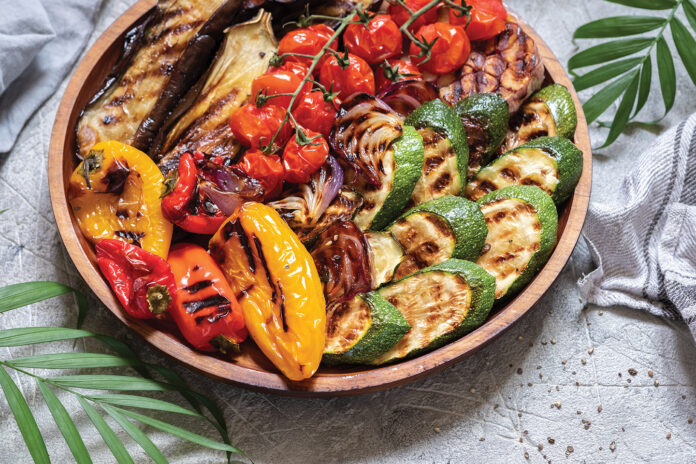
At this time of the year, many become diet conscious and look for healthier foods. Of course, part of a better approach is moderation in quantity. And Julia Child’s advice to keep moderation in moderation is classic. I offer two recipes that are moderately caloric yet delicious and, as with my stated goal in award-winning “Deep Flavors,” are made with non-processed and healthy ingredients: Dill French Toast and Indian-Style Grilled Chicken.
Dill French Toast
There are many French toast recipes, including various recipes for stuffed French toast with sweet toppings and with various sweet combinations of spices and sugar, all flavorful but laden with calories. Rarely do you see a recipe for a savory French toast. This recipe is quick and easy to make using various leftover (but not stale) breads. It is a wonderful, quick weeknight dinner with a salad and, with no added sugars, kind to the waistline.
French toast and bread puddings recipes frequently call for stale bread, but with the availability of freezers, why would you let bread stale? And if you did, why would you use it? If you want a dry bread to provide better liquid absorption (which is the stated rationale for recommending stale bread), use the oven at a low heat (225℉ or less) to dry the bread.
Ingredients:
- bread (see below for tips)
- eggs (at least 1 egg per slice of bread — extra is fine)
- milk product, 2–3 tablespoons per egg (milk, or if calories are not a concern, heavy cream, whipping cream, or half-and-half)
- salt and pepper to taste
- dill weed freshly
- chopped chives (optional)
- unsalted butter for sautéing
For this purpose, I normally use whole milk. Dried dill weed should be in your grocer’s spice rack. This dish is excellent and somewhat different with a liberal quantity of fresh, finely minced dill and chives.
The type of bread is an important consideration; while an ordinary good-quality bread (including challah or sourdough) can be used, this French toast is even better with a bakery (including your grocery’s bakery) flavorful pumpernickel or Jewish rye. A sturdy bread is essential. Ordinary grocery-store, white sandwich bread will disintegrate and does not fill the bill for this purpose or much else.
The technique is simple. Add the milk product to the eggs and beat thoroughly with the salt, pepper, dill weed, and chives (optional). The dill weed sometimes is difficult to incorporate into the eggs. Use a liberal quantity of the milk product; this is more like a custard than scrambled eggs. Soak the bread in the egg mixture. I prefer the bread to be thoroughly soaked so that the egg mixture penetrates through to the middle of the bread — ergo, the reason for using a sturdy bread. I generally use a generous amount of egg (more than 1 egg per slice of bread).
After the bread is soaked, heat a pan with butter. I cannot imagine for this purpose using any oil product other than unsalted butter; this is all about flavor, and butter is no more caloric than any other fat. Sauté the bread to the desired degree of doneness. I do not like my French toast overcooked, so I cook it just to a point where the egg is cooked, but the bread is still moist on the inside. My wife, on the other hand, likes her French toast cooked longer. It is a matter of taste. After the bread is mostly cooked, pour the remaining egg mixture over the bread in the skillet. This is comfort food, not haute cuisine. Finish cooking the bread with the egg. Since this is a savory dish, serve as is without any syrup or other sweetener.
Note: Bread stales at refrigerator temperatures. Either use bread right away or freeze it. Thawed bread tastes perfectly fresh. Thaw at room temperature; microwaving does something unpleasant to the bread’s texture and toughens it.
Note: Whipping cream has a lower fat content than heavy cream. Even heavy creams have varying fat contents depending on the brand — read labels. Purchase the one with the greatest fat content available.
Indian-Style Grilled Chicken
While “Deep Flavors” is a kosher-style cookbook, the recipes are eclectic, Tex/Mex to Cajun to Jewish soul food, to French, etc. This recipe is just one example. It is not truly Indian, in the sense that I suspect no Indian chef has actually made anything exactly like this recipe, just as I suspect no Italian nonna ever made my Texas State Fair Blue Ribbon Mushroom-Spinach Lasagna (see Chapter 12). However, it adheres to my goal of wonderful flavor; the Indian flavors are accessible to the home cook while meeting the laws of kashruth relating to mixing milk and meat. It is a riff on tandoori chicken commonly served in Indian restaurants, but I think better. As with other variants in “Deep Flavors” (for example, Bouillabaisse à La Juive, see Chapter 6), this recipe is intended to be includable in a kosher kitchen but equally attractive to the non-Jewish cook. It certainly meets the standard of “Deep Flavors.” Therefore, unlike a traditional tandoori chicken, which is marinated in regular milk yogurt, this chicken is marinated in a delicious coconut- or almond-based non-dairy yogurt. It can be roasted skin-side up in a 350°F oven for 30 to 40 minutes if a grill is not available. As with most grilled items, this recipe is very simple to execute. Note that the chicken, while somewhat different, is still yummy, even if the yogurt is not available (or you want to avoid the calories).
The tandoori and garam masalas, as well as other Indian spice mixtures or masalas, are available for purchase at many ethnic Indian food stores, Penzeys’s website, and, increasingly, at your local grocery store or online from American spice companies that are certified kosher. There are a number of recipes just for garam masala that are regional variants based on the source in India, and I have included the recipe I use in “Deep Flavors” in Chapter 2.
Ingredients:
This recipe is easily multiplied
- 8 chicken thighs (bone-in and skin on — these add flavor and protect the meat during grilling)
- about 1 cup of coconut or almond yogurt (preferably unsweetened and containing no milk products)
- 1 tablespoon or more tandoori masala (or another masala as desired)
- 1 tablespoon or more Garam Masala (Chapter 2)
- 2 tablespoons or more fresh ginger, finely minced or mashed to a paste
- 3 or more cloves garlic, finely minced or mashed to a paste
- 1 teaspoon ground peppercorns
- salt to taste
- ½ cup or so cilantro, finely chopped or ground
Using a mortar and pestle (or, if you do not have a mortar and pestle, use a blender or food processor), make a paste of all of the ingredients except the chicken and yogurt. Use kosher salt to facilitate the grinding. Then add the spice mixture to the yogurt. Spread the yogurt-spice paste liberally over the chicken, and let it sit for up to ½ an hour, covered.
When moving to the preheated grill, it is best to have a section of the grill that you turn off as you start to put the chicken on the grill so that you will have an area where you can cook the chicken over indirect heat to avoid flare-ups and burning. Start the chicken skin side down, flipping as necessary and moving to cooler sections until the chicken is thoroughly cooked to at least 165°F internal temperature next to the bone. Move to indirect cooking as needed. I find that a Thermapen or similar instant-read thermometer is essential to obtain a perfectly cooked grilled product.
I serve this chicken with Lemon Coconut Rice (see Chapter 9), or if I am serving Indian-Style Lentils (see Chapter 14), I frequently just serve with plain white basmati rice. Leftover chicken makes a great snack or lunch.
For a vegetable, I suggest Pan-Roasted Cauliflower (see Chapter 14); you may want the variation before roasting, when rubbing on olive oil and garlic powder, of adding a sprinkle of Garam Masala and/or sweet curry powder over the cauliflower. (Sweet curry powder is the very yellow curry powder mixture we are all familiar with. I think the mixture sold at Penzeys is superior to what is available in regular groceries, but it is not kosher.) Squeeze on lemon juice about 5 minutes before removing it from the oven and serving. An easy alternative is simple grilled vegetables: zucchini, eggplants, carrots, peppers, etc., with a mustard mayonnaise side (see Chapter 14) either warm or room temperature, easily made a day in advance.
For dessert, if you are tired of watching calories, Lemon-Coconut Custard Cherry Pie or Chocolate-Orange-Almond-Coconut Biscotti (both recipes in Chapter 15) is delicious; or perhaps you would prefer a small serving of Poached Fruit (also in Chapter 15), with or without vanilla ice cream.
“Deep Flavors” includes many sensational and detailed recipes such as the familiar but reimagined favorite, Deconstructed Turkey, designed to produce a perfectly cooked bird with bountiful sauce and stuffing every time, to unique and delectable desserts like German’s Sweet Chocolate Cake, to advice on how to enhance ingredients (from asparagus and mushrooms to nuts), plus the many other eclectic recipes and ideas. These all combine to make award-winning “Deep Flavors” a valued gift for your loved ones or friends who love to cook. (“Deep Flavors” is available in Kindle and hardcopy from Amazon or hardcopy from www.deepflavorscookbook.com).
About the author: Kenneth M. Horwitz, JD, LLM (Tax), CPA, practices as a lawyer in a general tax, estate planning, and transaction practice. Mr. Horwitz developed a creative and focused approach in finding and fixing problems, a skill that translates well to his passion for developing recipes based on traditional family favorites, tailored to personal taste and dietary needs. His desire to preserve and communicate that work led to “DEEP FLAVORS.”














